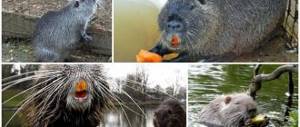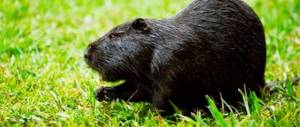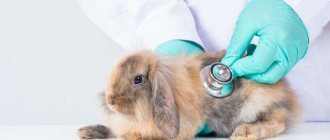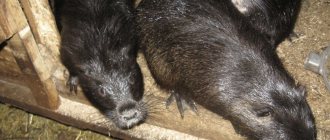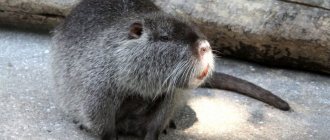Infectious diseases
Paratyphoid fever (salmonellosis)
Paratyphoid fever, or salmonellosis, is an acute disease.
The source of infection is contaminated water, food, especially animal origin, and sick animals. The infection can be brought to the farm by mice, rats, pigeons, crows, insects, domestic animals and birds, and humans. Young animals are most sensitive to paratyphoid. The incubation period lasts from 3 to 20 days. The clinical signs of paratyphoid fever in nutria are varied and do not make it possible to make an accurate diagnosis without laboratory tests. Two or three fresh corpses of animals or their entrails are sent to the laboratory for analysis.
Paratyphoid fever in nutria occurs in acute, subacute or chronic form. During the acute course of the disease (3-15 days), the animals refuse to feed, they become feverish, mucous or bloody discharge from the nose is observed, the feces are liquefied, sometimes with blood. Mortality in the acute form of paratyphoid reaches 90% of the number of sick animals.
On farms affected by paratyphoid fever, the veterinarian vaccinates the entire nutria population. After 7-8 months, vaccination must be repeated.
If there are already cases of nutria dying from paratyphoid on the farm, they are first given antibiotics or furazolidone with food. Further treatment is carried out by a veterinarian.
Pasteurellosis
Pasteurellosis or hemorrhagic septicemia is an acute infectious disease caused by bacteria of the Pasteurella species. Nutria become infected with pasteurellosis, as well as paratyphoid, mainly through consumption of infected feed, water and contact with sick animals. Infection carriers include rodents, pigeons, domestic animals and birds.
Pasteurellosis most often affects young nutria up to 6 months of age. The incubation period is very short - 1-3 days; the illness lasts from 12 hours to 2-6 days. In acute or hyperacute cases, nutria lose their appetite and become lethargic. They become drowsy; they experience vomiting, salivation, discharge of mucus mixed with blood from the nose, and dilution of stool. Some animals die suddenly, without visible clinical signs, as if they were poisoned. Mortality with pasteurellosis is up to 95% of the number of sick young animals; among adult nutria it is lower.
Antibiotics are used to treat nutria: oxytetracycline, streptomycin, ionomycin, penicillin - 25-50 thousand units intramuscularly. per 1 kg of live weight 2-3 times a day until recovery. For prevention, you can use a special emulsified vaccine, which is administered to nutria intramuscularly.
Colibacillosis
Colibacillosis is an acute infectious disease of young nutria. The causative agent is pathogenic variants of Escherichia coli. Sources of spread of this infection are sick animals, rodents, contaminated food and water.
The incubation period lasts from 3 to 5 days; The duration of the disease is 10-15 days with a loss of up to 90% of the number of sick people. The final diagnosis is established by bacteriological examination.
To prevent colibacillosis, nutria are treated twice with a polyvalent vaccine against paratyphoid and colibacillosis of fur-bearing animals, birds, calves and piglets - in a dose of 1-2 ml per head. Sick nutria are injected with serum against bacteriosis of calves in a dose of 5-10 ml per head. In addition, antibiotics are used (the same as for paratyphoid fever).
Ringworm
Ringworm is the collective name for dermatomycosis (trichophytosis and microsporia). Nutria often suffer from trichophytosis, caused by the fungus Trichophyton. Sources of infection are sick rodents, including rabbits, rats, as well as foxes, cats, dogs, and humans. Often, infection occurs when sawdust and straw, eaten away by mouse-like rodents and affected by a pathogenic fungus, are used for bedding.
Trichophytosis usually affects young nutria from 2 to 10 months of age, especially in the winter-spring period: adult animals (over a year old) and suckling young animals are less susceptible to this disease. In the summer, when nutria are kept in outdoor cages with pools and exposed to sunlight, the disease takes on less pronounced forms and subsides.
The incubation period lasts from 8 to 30 days. Most often, the fungus affects areas of skin and hair on the head, neck, and less often on the back and sides. There is almost no trichophytosis on the abdomen, where the hair is very thick and it is difficult for the fungus to penetrate the skin. With trichophytosis, characteristic round whitish-grayish spots with a diameter of 1 to 3-4 cm or more appear on the animal’s skin. In these places, the skin is inflamed and covered with small blisters, scabs or scales. The hair in the affected areas falls out of the hair follicles, breaks and, as it were, is “cut.”
The final diagnosis is made on the basis of microscopic examination of scrapings from the affected areas. Sick nutria are immediately isolated and treated under the supervision of a veterinarian; severely affected ones are killed.
The disease lasts about 4-5 months, then, even without treatment, the animals gradually recover: the crusts fall off, the skin in these places becomes bare and over time grows overgrown with hair (at first of a darker color).
Invasive diseases of nutria (coccidiosis, fascioliasis and other helminthiasis) have been little studied. The main attention should be paid to their warning. Keeping nutria in cages with a mesh floor allows you to disrupt the development cycle of coccidia and many helminths (worms) and get rid of them.
The disease of coccidiosis and helminthiasis is observed when animals are kept in cages with an earthen floor, especially when irregular cleaning of paddocks, houses and pools is carried out.
To prevent fascioliasis, you should not give nutria water from open, stagnant bodies of water (ponds, marshy lakes) and feed them grass cut in areas where there are mollusks and small pond snails.
What nutria diseases are dangerous for humans?
All of the infectious and parasitic diseases described above can be contracted by a person from animals or become a carrier of the disease. To avoid infection, you need to follow the rules of personal hygiene. When caring for rodents, use special clothing, rubber gloves and boots.
You should not eat meat from sick or recently recovered animals. After all, many pathogenic bacteria, even with proper treatment of nutria, still remain active, and if the product is poorly processed, pathogens may remain.
| Ringworm | The hair on the affected areas falls out and the skin peels off and becomes covered with scabs. | Treat with 10% iodine tincture or 1–1.5% Yuglone ointment. |
| Salmonellosis or paratyphoid fever | Increased temperature, diarrhea, arthritis, conjunctivitis, loss of appetite. | Treatment is carried out with antibiotics "Levomycetin", "Chlortetracycline", sulfonamide drugs "Norsulfazol", "Etazol". |
| Pasteurellosis | Lack of appetite, depression of general condition, increased breathing, mucopurulent discharge, convulsions, arthritis, enlarged lymph nodes. | The drugs used are “Tetracycline”, “Penicillin”, “Sulfadimethoxine”. |
| Streptococcosis | Increased body temperature, diarrhea, arthritis, loss of appetite, paralysis of paws, serous-purulent snot. | They are treated with the medications Bicillin-5, Norsulfazol, and Streptocide. |
| Helminthiasis | Vomiting, temperature up to +40°C, slow growth, lethargy, weight loss. | Treatment is carried out using the drugs “Hexachloroethane” and “Levamisole”. |
| Coccidiosis | Exhaustion, diarrhea, lethargy, bluish skin, loss of coordination, paresis of the limbs. | They are treated with Furazolidone and Sulfamethacin. |
| Tularemia | Increased temperature, serous-mucous discharge, diarrhea and vomiting with blood, cough, inflamed lymph nodes. | There is no treatment. |
| Tuberculosis | Shortness of breath, cough, diarrhea, lethargy, dull coat, exhaustion. | There is no treatment. |
| Colibacillosis | Diarrhea, dehydration, convulsions, disheveled hair, loss of appetite, inactivity, mass spontaneous abortions. | They give the drugs “Furazolidone”, “Levomycetin”, “Biomitsin”, “Nifulin”, and administer immune serums. |
| Listeriosis | Depressed state, convulsions, bleeding, paralysis, weight loss. | There is no treatment. |
At home, with careful care and timely preventive procedures, you can breed a healthy nutria population. And as a result, get high-quality dietary meat and good profit from the sale of skins.
To prevent diseases, it is necessary to monitor the cleanliness of cages, pools and paddocks, regularly remove manure and change bedding. All dead animals are burned, and if infection is suspected, the carcasses are sent to a veterinary clinic for analysis. Information from this article will help you identify and prevent nutria diseases in a timely manner.
It describes which pathologies occur most often in animals, what symptoms characterize certain ailments, and what treatment methods should be taken to eliminate them.
Non-communicable diseases
Respiratory diseases
The main reason for their occurrence is hypothermia of nutria and drafts due to poor insulation of houses in the cold season or due to excessive ventilation indoors.
Rhinitis
Rhinitis (runny nose) is an inflammation of the nasal mucosa with the release of grayish mucus and the formation of dry crusts that make breathing difficult. The crusts around the nutria's nose should be lubricated with boric petroleum jelly or glycerin, moistened with warm water and removed with tweezers, and the nasal mucosa should be irrigated with a solution of penicillin (1:100) until recovery.
Bronchitis
Bronchitis is an inflammation of the bronchi, often combined with rhinitis. Animals often sneeze, their breathing is hoarse, and mucus comes out of their nose. Treatment as directed by a doctor - antibiotics and sulfonamide drugs. It is necessary to eliminate the main cause of the disease - hypothermia of nutria, drafts in the room, etc.
If hypothermia occurs, nutria may develop bronchitis or pneumonia.
Pneumonia
Pneumonia - acute or chronic inflammation of the lungs often occurs as a complication after rhinitis or bronchitis. Dry or moist wheezing is heard in the lungs. Treatment is carried out by a veterinarian.
Gastrointestinal diseases
The reasons for their occurrence are feeding of poor quality, inferior or contaminated feed with pathogenic microbes and violation of the feeding regime of animals.
Poisoning
Poisoning, often fatal, occurs if food and water are contaminated with pesticides, high in nitrates and nitrites, contaminated with pathogenic microorganisms, fungi and their toxins, contain poisonous herbs (buttercup, hemlock, aconite, celandine, hemlock, etc.) or a large amount of table salt. Typically, when poisoning occurs, vomiting, salivation, thirst, loss of appetite, dilution of feces, depression and paralysis are observed. To avoid poisoning, you need to constantly monitor the quality of feed and water; new feeds must first be tested for safety on several nutrias over a period of 7-10 days.
In case of any poisoning, you need to give the nutria clean water and put milk (4-5 dessert spoons) or a weak solution of potassium permanganate into the mouth, and give warm enemas. It is recommended not to feed the animal for 12-16 hours and replace the food with new, benign food.
Catarrhal gastroenteritis
Catarrhal gastroenteritis is inflammation of the stomach and intestines with liquid stool with a sour odor. The main cause of this disease is the provision of poor-quality food or water, a sharp transition from one type of feeding to another.
In case of acute gastrointestinal catarrh, the animals must be put on a starvation diet on the first day; Introduce a laxative through the mouth - 3-5 ml of a 5-10% solution of Glauber's salt, and then a disinfectant - salol (0.1-0.2 g twice a day) or a teaspoon of potassium permanganate solution (0.2 g per 200 ml of water).
Tympany
Tympany - bloating of the stomach under the influence of gases and flatulence - bloating of the intestines are rare in nutrias. Their reasons are feeding stale or warm, easily fermented feed.
Gastric diseases in nutrias can be caused by poor quality food or poor water.
Prevention of diseases in nutrias
It is better to prevent the occurrence of a disease than to treat it. Especially considering that some are fatal. Following simple recommendations will help protect your livestock from infection.
So, in order to reduce the risk of pathology in nutria, it is necessary to perform the following work:
- at the entrance, lay a mat that is regularly moistened with a creolin solution;
- the container used for cooking must be clean;
- Before feeding, the feed is checked for the presence of infections;
- water must be clean and free of pathogenic microorganisms;
- It is better to buy livestock from proven farms;
- infected individuals are isolated (if necessary, sick individuals are slaughtered)
In addition, it is necessary to promptly disinfect and clean the cages in which animals are kept.
Regular cleaning of huts, paddocks and pools
To prevent diseases, cages, equipment, equipment and paddocks need to be disinfected twice a year. Before disinfection, there should be no animals in the cage; they should be cleared of manure, food residues and dirt.
The cells are washed with hot water and then treated with one of the following disinfectant solutions:
- Two percent solution of soda ash;
- Dezmol, chloramine, nirtan are used for wet disinfection;
- In the warm season, equipment and cages can be disinfected with a solution of creolin or formaldehyde;
- Bleach is used to disinfect dirt floors and soil in paddocks.
The disinfectant solution is applied to a surface cleared of manure and litter, left for an hour, and then washed off with a stream of hot water.
Next, the cage and equipment must be dried and additionally treated using wet or aerosol disinfection with the solutions listed above.
Before carrying out aerosol disinfection, you need to tightly close all windows and doors in the room and maintain a stable temperature no higher than 15 degrees.
Wooden cells are treated with hot water or boiling lye. The skins of individuals infected with infectious diseases are treated with a solution of formalin or carbolic acid. If the skin is infected with a fungus, it is immersed in a warm solution of table salt and sulfuric acid for two days.
Disinfection of equipment
Drinking bowls, as well as all other equipment, can be disinfected regularly. They use a blowtorch, hot water and disinfectants. Feeders are processed several times throughout the month.
Unscheduled disinfection is carried out in cases where new purchased livestock are moved into a cage, as well as after detection of infected swamp beavers.
Checking the quality of feed Many infectious diseases are transmitted through water and food consumed by animals. This means that it is necessary to carefully monitor the quality of feeding. It is strictly forbidden to give nutria rotten and moldy foods. This also applies to low-quality feed.
Water can be analyzed regularly and replaced daily. To disinfect feed and food products, they can be treated with steam and steamed.
High temperature negatively affects the state of pathogens. As a result, they die, which eliminates the possibility of infection of the animal.
Frostbite
Frostbite is possible in cold weather (-10°C and below) when nutria are kept in outdoor cages with poorly insulated houses (without bedding). First of all, the slightly pubescent tail gets frostbitten, and less often, the paws and ears. The frostbitten tip of the tail sometimes dries out and falls off on its own; more often, damage to the tail is accompanied by the formation of deep wounds with suppuration.
It is better to amputate a frostbitten tail or its tip. The tail is cut off with a sharp knife in an area of healthy tissue, between two vertebrae. The wound is not sutured, but cauterized with iodine.
Injuries
Adult nutria are pugnacious. When kept in crowded conditions, especially in heterogeneous groups, as well as during mating between animals, fights often occur with injuries.
In case of a wound with damage to large vessels, it is necessary first of all to stop the bleeding by applying a pressure bandage, then treat the edges of the wound with 5% tincture of iodine, and wipe the wound with a swab soaked in a solution of potassium permanganate and sprinkle with white streptocide or iodoform powder.
Small superficial wounds in nutria heal quickly and do not require special treatment. They are lubricated with iodine or 3% hydrogen peroxide.
